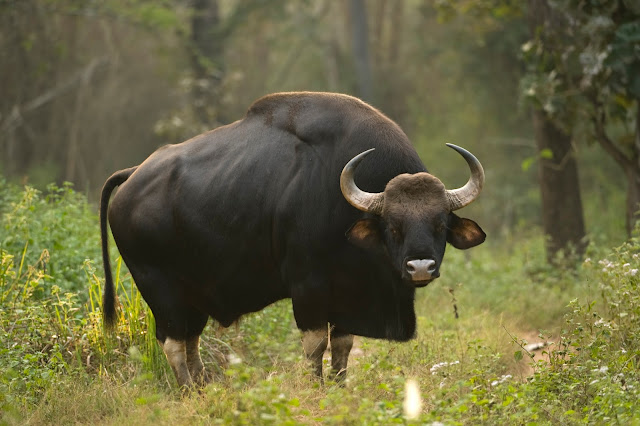Historical Creature - Pangolin or Scaly Anteater
We all see wild animals like Tiger, Lion, Elephant, Rhino, Leopard etc...
It seem like these animals are a real world or say Morden or present time animals.....
But some animals are looked like past time animal or Historical Creatures....
Now our safari is to see one of that historical creatures - "Pangolin or Scaly Anteater"
Introduction
- The Indian Pangolin, thick tail Pangolin or scaly anteater, scientific name is Manis crassicaudata.
- It is found in plains and hills of India, Sri Lanka, Nepal, Bhutan. It is not common anywhere in its range.
Physical Characteristics
- The Indian Pangolin is a solitary, shy and slow moving, nocturnal mammal.
- It is about 84-122 cm long from head to tail, the tail is usually being 33-47 cm long.
- It weights 10-16 kg.
- Females are generally smaller than males and have one pair of mammie.
- The pangolin possesses a cone-shape head with small, dark eyes and a long muzzle with a nose pad similar in colour or darker than its pinkish brown skin.
- The pangolin has no teeth, but has a strong stomach muscles to aid in digestion.
- The most noticeable characteristic of the pangolin is its massive, scaled armour which covers its upper face and its whole body with the exception of the belly and the inside of the legs.
- These protective scales are rigid and made of keratin.
- It has 160-200 scales in total, about 40-46 % of which are located on the tail.
- Scales are 6.5-7 cm long . 8.5 cm wide and weight 7-10 gm, skin and scales make up about one fourth to one third of the total body mass.
Behaviour
- The Indian pangolin is solitary, mostly noctumal and terrestrial.
- These Pangolins dig their own burrows in the ground, at depth of 1.5- 6 m ; these are frequently under large rocks and the entrance is often hidden with soil.
- When in danger, they roll up into balls, with their large tails press tightly against face and belly to help protect themselves.
- Longevity of this animal in captivity can exceed 19 years.
- Indian pangolins are nocturnal and mostly active intermittently between 17:00 and 05:00 hr. The peak period of activity was observed between 20:00-21:00 hr in captive individuals with some one individual variation.
Diet
- Its diet includes beetles, cockroaches, termites, and worms but mainly ants and termites.
- It feeds on the eggs, larvae and adults of its prey, but eggs are the preferred choice.
Reproduction
- During the animal's mating period, females and males may share the same burrow and show some diurnal activities.
- Males have testes in a fold of the skin located in their groin area.
- The Female's embryo develops in one of the uterine horns.
- The gestation period lasts 65-70 days; a single young is born, but twins have been reported in this species.
- The young weight 235-400 gm at birth and measure roughly 30 cm. The new-born animals have open eyes, soft scales with protruding hairs between them.
- The mother pangolin carries her young on her tail. When mother and young are disturbed, the young pangolin is held against its mother's belly and protected by the mother's tail.
Habitat
- The Indian Pangolin has been recorded from various forest types, including Sri Lankan rainforest and plains to middle hill levels.
- The animal can be found in grasslands and secondary forests, and is well adapted to desert regions as it is believed to have a tolerance to dry areas, but prefers more barren, hilly regions.
- It is distributed throughout India, Pakistan and South Asia occurring in Sialkot, Jhelum, Gujarat, Districts northwest of Punjab, Kohat, Attock, Khyber, Sindh and Baluchistan
Haman interaction and Conservation
- Although the Indian Pangolin is protected by national legislation in many protected areas throughout its range, it is heavily exploited for its flesh, scales and skin.
- Illegal demand has increased over the past 20 years. populations are declining due to the hunting and poaching for both subsistence and international trade.
- As they have a single offspring per year, this high demand is starting to seriously endanger populations.
- Pangolins are the most heavily trafficked CITES-protected mammal.
- The two other Asian species of pangolins are also declining due to the market in Chinese traditional medicine.
Some Interesting Facts about Pangolin
- They do not have teeth and are unable to chew. Instead, they have long sticky tongues that they use to catch the insects they feed on.
- They have two chambered stomach that crushes their food for them.
- Pangolins have poor vision and hearing, but their sense of smell is quite strong.





Comments
Post a Comment